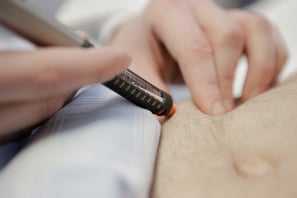Lipohypertrophy - Background
Lipohypertrophy (LHT) is a common side effect of long-standing insulin therapy in patients with diabetes mellitus. Lipohypertrophic lesions are characterised by a palpable tumour-like thickening of subcutaneous adipose tissue. Cross-sectional studies from different countries such as Germany, Ethiopia and Spain reported prevalences of LHT ranging between 28% to over 64% predominantly in patients with type 1 diabetes mellitus. Although the exact aetiology of LHT is unclear, factors such as duration of insulin treatment, needle reuse and frequent injection into same tissue areas due to missing or wrong injection site rotation may play an important role in the development of LHTs. In particular the latter factor, incorrect injection and rotation techniques, are widely observed in clinical daily practice. Patients with LHTs often state that insulin administration into same areas make insulin therapy easier due to easy access and/or less pain in the usually chosen injection sites.

The effects on blood glucose control
It is discussed whether insulin absorption from lipohypertrophic lesions compared to normal adipose tissue is impaired and leads to higher glucose variability. From a clinical perspective impaired insulin absorption from LHT seems to be quite obvious since several case studies describe substantial improvements in glucose control after retraining patients in injection site rotation techniques and avoidance of LHTs as reflected by HbA1c reduction of more than 2% within only a few months (Chowdhury et al, 2003). From a scientific point of view only few studies compared insulin pharmacokinetics (PK) and pharmacodynamics (PD) after administration into LHT and normal adipose tissue. Two recent reports conducted by Johannson et al. in 2005 and Overland et al. in 2009 demonstrated reductions in maximum insulin concentration (Cmax) of 25-30% after injection of short-acting insulin analogues into LHT prior to a meal but this effect was only statistically significant in the first study. Surprisingly, both studies failed to demonstrate statistically significant differences in blood glucose profiles. To this end, Overland et al. concluded that no recommendation could be given to generally avoid LHTs for insulin injection. One limitation of both studies is the small sample size (N=9 and 8, respectively) and the highly variable results which makes data interpretation difficult and leaves the question about the magnitude of insulin efficacy after injection into LHT vs. normal tissue open. In addition, no recently published study used a sophisticated method such as the glucose clamp technique to investigate the impact of LHTs.
Designing an optimal study design to answer open questions
We therefore designed a randomised open label cross-over trial to investigate PK and PD profiles of insulin lispro after injection into either lipohypertrophic or normal tissue in patients with diabetes mellitus type 1. In this study we used both state-of-the-art euglycaemic clamp and mixed meal tolerance testing. Furthermore, the trial design included repeated insulin injection into LHT and normal adipose tissue during the clamp procedure in order to determine potential influences of LHT on intra-subject variability of insulin absorption and efficacy. The results of this trial should expand our knowledge on the severity of this issue and will be presented for the first time during the 75th Scientific Session of the American Diabetes Association (ADA).
Avoiding lipohypertrophy all together?
As lipohypertrophy is a problem that affecting many patients, recent developments regarding the feasibility of avoiding insulin injection all together may limit LHTs itself or at least its potential consequences. Many attempts have been made to develop oral insulins, inhalable insulins or other modes of insulin administration. There have been only few successful developments and to date s.c. insulin injection remains to be mainstay of insulin administration. We are hosting a online seminar to discuss past and present developments and how this might change the future of insulin therapy.





